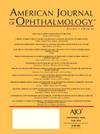使用扫描源OCT血管造影检查老年性黄斑变性患者的绒毛膜毛细血管的最新指南。
IF 4.1
1区 医学
Q1 OPHTHALMOLOGY
引用次数: 0
摘要
目的:更新使用扫源光学相干断层扫描血管造影(SS-OCTA)量化老年性黄斑变性(AMD)患者的绒毛膜毛细血管(CC)血流缺陷(FDs)的推荐指南。设计:基于证据的视角。方法:查阅文献并结合作者的经验。结果:当前使用SS-OCTA量化CC fd时面临的挑战是实施客观补偿策略,以调整AMD眼睛中因疲劳引起的信号衰减。我们以前的补偿策略被用作一般方法来调整与大多数频率相关的OCTA信号衰减。然而,过度使用下OCTA信号损失的可变性需要一种更客观的策略,可以针对每个病例量身定制。我们提出了一种使用参数γ (γ)的补偿策略,该策略允许选择适当的补偿水平。最佳γ值被确定为在整个CC结构板上产生最均匀OCT信号的值。这种方法最大限度地减少了补偿CC流量图像中流量减少的区域可能反映与吸毒相关或补偿相关的伪影而不是真正的缺陷的可能性。在量化CC fd时,其他病变也面临着独特的挑战,包括由钙化结节(CaD)和高反射灶(HRF)引起的脉络膜低透射缺陷(hypods),以及由萎缩灶引起的脉络膜高透射缺陷(hypertd)。我们建议在Bruch膜(BM)下64至400µm的表面视网膜下色素上皮(subpe)板上识别并概述这些区域。由于缺乏明显的OCTA信号,应该从CC量化中排除hypotd,而hypertd应该被排除在补偿之外,因为这样做会人为地增加CC fd的百分比。结论:在AMD的CC fd分析中,需要特别注意dren、hypopods和hyperTDs,以避免引入伪影。通过适当调整疲劳下的代偿水平,并通过考虑高tds和低pods来调整CC fd的量化,对测量AMD中CC fd感兴趣的研究人员可以对他们的测量更有信心,特别是在研究CC血流损伤在AMD进展中的作用时。本文章由计算机程序翻译,如有差异,请以英文原文为准。
Updated Guidelines for Imaging the Choriocapillaris in Eyes with Age-Related Macular Degeneration Using Swept-Source Optical Coherence Tomography Angiography
PURPOSE
To update the recommended guidelines when quantifying choriocapillaris (CC) flow deficits (FDs) in eyes with age-related macular degeneration (AMD) using swept-source optical coherence tomography angiography (SS-OCTA).
DESIGN
Evidence-based perspective.
METHODS
Review of literature and experience of authors.
RESULTS
A current challenge when quantifying CC FDs using SS-OCTA is the implementation of an objective compensation strategy to adjust for the signal attenuation arising under drusen in eyes with AMD. Our previous compensation strategy was used as a general approach to adjust for the OCTA signal attenuation associated with most drusen. However, the variability of the OCTA signal loss under drusen necessitated a more objective strategy that could be tailored to each case. We propose a compensation strategy using a parameter gamma (γ) that allows for the selection of an appropriate compensation level. The optimal γ value is identified as the one producing the most homogeneous OCT signal across the whole CC structural slab. This approach minimizes the possibility that areas of decreased flow in the compensated CC flow image might reflect drusen-related or compensation-related artifacts rather than true deficits. Additional lesions that present unique challenges when quantifying CC FDs include the presence of choroidal hypotransmission defects (hypoTDs) caused by calcified drusen and hyperreflective foci as well as choroidal hypertransmission defects (hyperTDs) caused by foci of atrophy. We recommend identifying and outlining these regions on an en face sub–retinal pigment epithelium (subRPE) slab with segmentation boundaries between 64 and 400 µm beneath the Bruch membrane (BM). The hypoTDs should be excluded from CC quantification because of the lack of significant OCTA signal, whereas the hyperTDs should be excluded from being compensated because doing so can artifactually increase the percentage of CC FDs.
CONCLUSIONS
The analysis of CC FDs in AMD requires special attention to drusen, hypoTDs, and hyperTDs to avoid introducing artifacts. By properly adjusting the compensation levels under drusen and adjusting the quantification of CC FDs by accounting for hyperTDs and hypoTDs, researchers interested in measuring CC FDs in AMD can have greater confidence in their measurements, particularly when investigating the role of CC flow impairment in AMD progression.
求助全文
通过发布文献求助,成功后即可免费获取论文全文。
去求助
来源期刊
CiteScore
9.20
自引率
7.10%
发文量
406
审稿时长
36 days
期刊介绍:
The American Journal of Ophthalmology is a peer-reviewed, scientific publication that welcomes the submission of original, previously unpublished manuscripts directed to ophthalmologists and visual science specialists describing clinical investigations, clinical observations, and clinically relevant laboratory investigations. Published monthly since 1884, the full text of the American Journal of Ophthalmology and supplementary material are also presented online at www.AJO.com and on ScienceDirect.
The American Journal of Ophthalmology publishes Full-Length Articles, Perspectives, Editorials, Correspondences, Books Reports and Announcements. Brief Reports and Case Reports are no longer published. We recommend submitting Brief Reports and Case Reports to our companion publication, the American Journal of Ophthalmology Case Reports.
Manuscripts are accepted with the understanding that they have not been and will not be published elsewhere substantially in any format, and that there are no ethical problems with the content or data collection. Authors may be requested to produce the data upon which the manuscript is based and to answer expeditiously any questions about the manuscript or its authors.

 求助内容:
求助内容: 应助结果提醒方式:
应助结果提醒方式:


